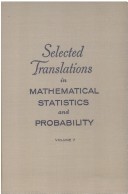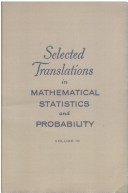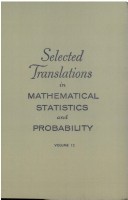Selected Translations in Mathematical Statistics & Probability
6 primary works
Book 1
Twenty-five Papers on Statistics and Probability
by I.V. Culanovskii, R.L. Dobrusin, E. B. Dynkin, I. I. Gihman, and B V Gnedenko
Published 15 December 1961
On April 7-10, 1980, the American Mathematical Society sponsored a Symposium on the Mathematical Heritage of Henri Poincari, held at Indiana University, Bloomington, Indiana. This volume presents the written versions of all but three of the invited talks presented at this Symposium (those by W. Browder, A. Jaffe, and J. Mather were not written up for publication).In addition, it contains two papers by invited speakers who were not able to attend, S. S. Chern and L. Nirenberg. If one traces the influence of Poincari through the major mathematical figures of the early and midtwentieth century, it is through American mathematicians as well as French that this influence flows, through G. D. Birkhoff, Solomon Lefschetz, and Marston Morse. This continuing tradition represents one of the major strands of American as well as world mathematics, and it is as a testimony to this tradition as an opening to the future creativity of mathematics that this volume is dedicated. This part contains sections on geometry, topology, Riemann surfaces, discontinuous groups and Lie groups, and several complex variables.
Book 3
Eighteen Papers on Statistics and Probability
by I.D. Cerkasov, A.Ja Dorogovcev, E. B. Dynkin, I.G. Girsanov, and B V Gnedenko
Published 15 December 1963
On April 7-10, 1980, the American Mathematical Society sponsored a Symposium on the Mathematical Heritage of Henri Poincari, held at Indiana University, Bloomington, Indiana. This volume presents the written versions of all but three of the invited talks presented at this Symposium (those by W. Browder, A. Jaffe, and J. Mather were not written up for publication).In addition, it contains two papers by invited speakers who were not able to attend, S. S. Chern and L. Nirenberg. If one traces the influence of Poincari through the major mathematical figures of the early and midtwentieth century, it is through American mathematicians as well as French that this influence flows, through G. D. Birkhoff, Solomon Lefschetz, and Marston Morse. This continuing tradition represents one of the major strands of American as well as world mathematics, and it is as a testimony to this tradition as an opening to the future creativity of mathematics that this volume is dedicated. This part contains sections on geometry, topology, Riemann surfaces, discontinuous groups and Lie groups, and several complex variables.
Book 7
Twenty-four Papers on Statistics and Probability
by A. Aleskjavicene, I.D. Cerkasov, Ljan Czi-suen, M.K. Gavurin, and Marius Iosifescu
Published 15 December 1968
On April 7-10, 1980, the American Mathematical Society sponsored a Symposium on the Mathematical Heritage of Henri Poincari, held at Indiana University, Bloomington, Indiana. This volume presents the written versions of all but three of the invited talks presented at this Symposium (those by W. Browder, A. Jaffe, and J. Mather were not written up for publication). In addition, it contains two papers by invited speakers who were not able to attend, S. S. Chern and L. Nirenberg.If one traces the influence of Poincari through the major mathematical figures of the early and midtwentieth century, it is through American mathematicians as well as French that this influence flows, through G. D. Birkhoff, Solomon Lefschetz, and Marston Morse. This continuing tradition represents one of the major strands of American as well as world mathematics, and it is as a testimony to this tradition as an opening to the future creativity of mathematics that this volume is dedicated. This part contains sections on geometry, topology, Riemann surfaces, discontinuous groups and Lie groups, and several complex variables.
Book 10
Thirty-two Papers on Statistics and Probability
by M Arato, F.E. Binet, Zoltan Daroczy, Ju.S. Davidovic, and A. Dobo
Published 15 December 1972
On April 7-10, 1980, the American Mathematical Society sponsored a Symposium on the Mathematical Heritage of Henri Poincari, held at Indiana University, Bloomington, Indiana. This volume presents the written versions of all but three of the invited talks presented at this Symposium (those by W. Browder, A. Jaffe, and J. Mather were not written up for publication). In addition, it contains two papers by invited speakers who were not able to attend, S. S. Chern and L. Nirenberg.If one traces the influence of Poincari through the major mathematical figures of the early and midtwentieth century, it is through American mathematicians as well as French that this influence flows, through G. D. Birkhoff, Solomon Lefschetz, and Marston Morse. This continuing tradition represents one of the major strands of American as well as world mathematics, and it is as a testimony to this tradition as an opening to the future creativity of mathematics that this volume is dedicated. This part contains sections on geometry, topology, Riemann surfaces, discontinuous groups and Lie groups, and several complex variables.
Book 12
Twenty Papers on Statistics and Probability
by Chen Hsi-ju, Chen Jia-ding, Chu Chen-shi, I. I. Gihman, and B V Gnedenko
Published 1 September 1973
On April 7-10, 1980, the American Mathematical Society sponsored a Symposium on the Mathematical Heritage of Henri Poincari, held at Indiana University, Bloomington, Indiana. This volume presents the written versions of all but three of the invited talks presented at this Symposium (those by W. Browder, A. Jaffe, and J. Mather were not written up for publication). In addition, it contains two papers by invited speakers who were not able to attend, S. S. Chern and L. Nirenberg.If one traces the influence of Poincari through the major mathematical figures of the early and midtwentieth century, it is through American mathematicians as well as French that this influence flows, through G. D. Birkhoff, Solomon Lefschetz, and Marston Morse. This continuing tradition represents one of the major strands of American as well as world mathematics, and it is as a testimony to this tradition as an opening to the future creativity of mathematics that this volume is dedicated. This part contains sections on geometry, topology, Riemann surfaces, discontinuous groups and Lie groups, and several complex variables.
Book 13
Twenty Papers on Statistics and Probability
by M Arato, A.Ja. Beleckii, A. Bikjalis, E.F. Carkov, and I.D. Cerkasov
Published 15 December 1973
On April 7-10, 1980, the American Mathematical Society sponsored a Symposium on the Mathematical Heritage of Henri Poincari, held at Indiana University, Bloomington, Indiana. This volume presents the written versions of all but three of the invited talks presented at this Symposium (those by W. Browder, A. Jaffe, and J. Mather were not written up for publication). In addition, it contains two papers by invited speakers who were not able to attend, S. S. Chern and L. Nirenberg.If one traces the influence of Poincari through the major mathematical figures of the early and midtwentieth century, it is through American mathematicians as well as French that this influence flows, through G. D. Birkhoff, Solomon Lefschetz, and Marston Morse. This continuing tradition represents one of the major strands of American as well as world mathematics, and it is as a testimony to this tradition as an opening to the future creativity of mathematics that this volume is dedicated. This part contains sections on geometry, topology, Riemann surfaces, discontinuous groups and Lie groups, and several complex variables.



